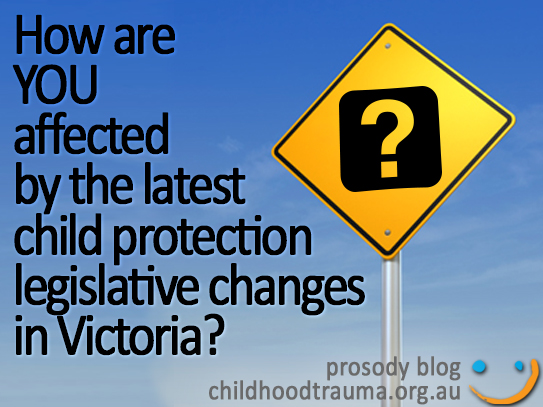
Changes in child protection law – what you need to know

Our work with the Safeguarding Children Program sees us connecting with a wide variety of organisations around Australia who are working with children and young people. One issue that proves tricky for many, is the constantly changing legislative landscape. We thought we might use this post to bring you up to date with some of the new laws in Victoria that affect ALL ADULTS in Victoria. We will look at other states and territories in subsequent posts.
In its response to the recommendations of Betrayal of Trust, the report of the Parliamentary Inquiry, tabled in November 2013 the government proposed several new Laws. Some of these laws are now in force.
Some relate to you as an individual. Others relate to your role within an organisation that works with children and young people. Fact Sheets giving details of these laws are available through the Victorian Justice Department. Click here
- Failure to disclose child sexual abuse On 27 October 2014 a new offence for failing to disclose child sexual abuse came into effect. This legislation requires any adult who holds a reasonable belief that a sexual offence has been committed by an adult against a child (aged under 16) to disclose that information to police unless they have a reasonable excuse. The offence applies to all adults, not just professionals who work with children. The legislation allows some exemptions on the basis of having a reasonable excuse for not disclosing. However what is considered to be a reasonable excuse is limited to specific circumstances that are detailed in the Act. Click here This new legislation is in addition to the existing mandatory reporting legislation requiring professionals such as doctors, nurses, police and school teachers to report suspected child abuse. It marks a significant broadening of the requirements for reporting child sexual abuse.
- Amendments to the Working with Children Check On 26 October 2014, a series of amendments were made to the Working with Children Act 2005. Details of the changes can be found here. In brief, these changes include to:

– Clarify that the purpose of the WWC Check is to ensure people who work with children are subject to a screening process rather than to assess their ‘suitability’
– Require that the protection of children be the paramount consideration for any decision made under the Act
– Clarify the definition of child-related work to (amongst other things): include the requirement for all ministers of religion to be checked and include accommodation provided at home as part of a Student exchange program as a new occupational field
– Remove the exemption for accredited drivers, revise the interstate worker exemption and clarify that Negative Notice holders cannot use any exemptions
– Ensure that the 3-month ‘grace period’ is removed so that workers can no longer do child-related work once their WWC Check has expired
– revise the classification of offences so that some offences are moved up a category (e.g. rape and attempted rape are now category A) and classification is now on the basis of charges rather than convictions (e.g. an individual charged with rape will be treated as category A). - Grooming offence On 9 April 2014, the Crimes Amendment (Grooming) Act introduced the offence of grooming for sexual conduct with a child under the age of 16 years. This offence targets predatory conduct designed to facilitate later sexual activity with a child. The Victim’s Charter Act 2006 was also amended to expressly provide that a child and a family member of that child are victims of a grooming offence and are entitled to provide a victim impact statement to a court. See here.
- Failure to Protect a Child from Sexual Abuse – Organisations A proposed ‘failure to protect’ offence will apply to people within organisations who knew of a risk of child sexual abuse by someone in the organisation and had the authority to reduce or remove the risk, but negligently failed to do so. It will not apply where a person takes reasonable steps to protect a child from the risk of abuse, for example, where the allegation is reported and the person removed from any child-related role pending an investigation. This law is expected to come into affect before July 2015.
- Child-Safe Organisations
All these laws are designed to assist in creating child-safe organisations. They are part of the suite of measures required to achieve the goal of protecting children and young people from abuse within the organisations that provide care and services to them.
The Victorian Government through the Commissioner for Children and Young People have also released a set of proposed standards it is seeking to introduce across Victoria.
DHS and the Commission for Children and Young People are working with key stakeholders to develop the minimum child safe standards. Consultation has taken place with key stakeholders during October 2014 to inform the content of the standards; which organisations will be included; and how organisations can be supported to meet the standards.
The Commission for Children and Young People is responsible for oversee the implementation of the standards, and is expected to be granted an expanded power to inquire into the child safety systems of all organisations working with children. The new standards are expected to commence on 1 January 2016.
Since 2009 the Australian Childhood Foundation’s Safeguarding Children Program has been assisting organisations to implement a suite of screening, recruitment, induction, training and reporting policies and procedures designed to ensure that their organisations are safe places for children and young people.
In its First Interim Report (2014), the Royal Commission into Institutional Responses to Child Sexual Abuse identified the Safeguarding Children Program as an example of a voluntary accreditation scheme for organisations with a duty of care to children. Over 40 organisations across Australia are engaged in our accreditation program and more are coming on board each day. For example, the Foundation is working with the Australian Sports Commission to support the evolution and implementation of a national child safe sports strategy.
It is an important period of reform in Australia. Organisations with a duty of care to children will need to ensure that they are equipped to support the changes as they emerge in each jurisdiction and nationally.
Check out our website at www.safegaurdingchildren.com.au if you want any more information about our work in this area.
This blog entry was written by David Ross,
Consultant with the Safeguarding Children Program.
